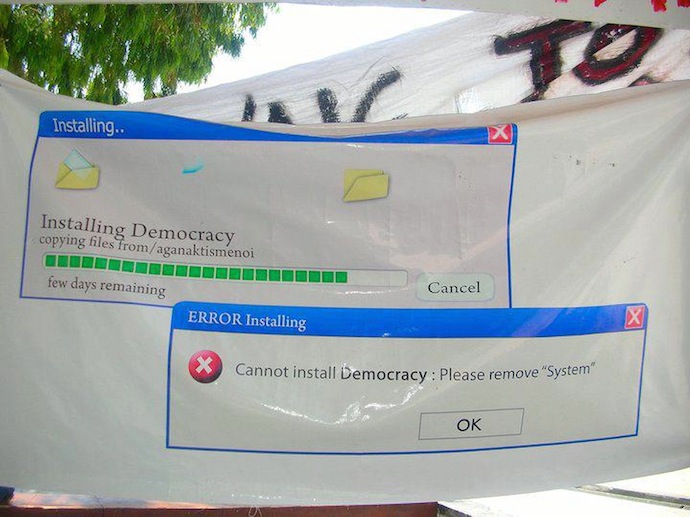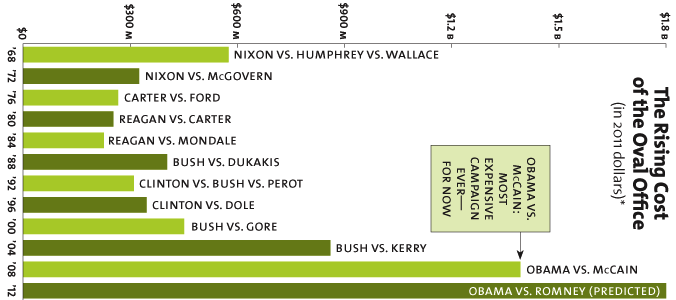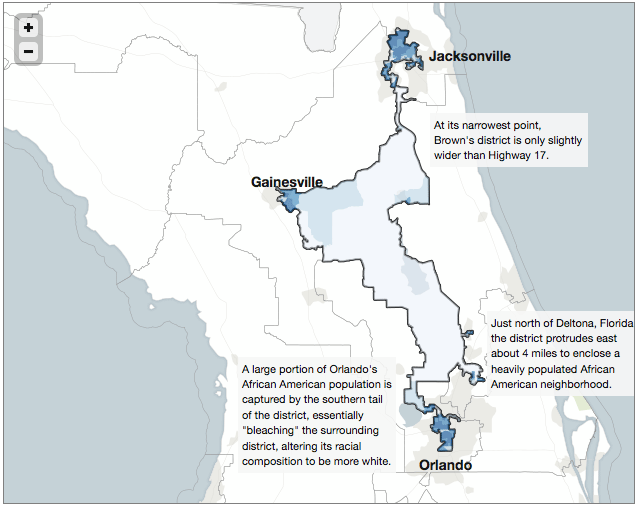Prepare for some strong language and laughs in regard to some real bullshit…
Go to Let My People Vote for info by state. Take a second now to make sure you won’t get sidelined in November.
Prepare for some strong language and laughs in regard to some real bullshit…
Go to Let My People Vote for info by state. Take a second now to make sure you won’t get sidelined in November.
Huh, “Home of Fair Play.” Never heard that one before…
[from Weirdo Video] [Related: Happy 235th!]

OK
“You got money in my politics!”
“You got politics in my money!”

What’s more unsettling, the amount being spent or the fact that it’s happening right out in the open?
Would it be more respectful to hide this from the public?
[Chart via the latest in Mother Jones’ coverage of Dark Money in politics]Still months away, the 2012 U.S. presidential election is already shaping up to be a real chore/bore. It’s as if we used up every bit of inspiration in 2008 and are now left to vote along party lines that are neither fun like a party nor straightforward like a line.
With the economy, it’s difficult to imagine either party promoting themselves, but given the likelihood that they will, here’s Businessweek’s recap of Obama’s efforts to straighten the ship…
Now we just need a chart on how this relates to reality.
Will there be a point before the robots take over when we elect machines to public office?
Consider the question again after looking at The Center for Public Integrity‘s Corruption Risk Report Card for state governments in the U.S….
Who would get the job with a transcript like that? Unfortunately, those are the jobs’ ratings! Now, fill the role with a human, factor in that power tends to corrupt and how power without status can produce worse results. Where are our expectations now?
The Center for Public Integrity’s plan is to bring attention to the specific risks of corruption and move along the slow process of reform. They’ve already helped accelerate efforts in five states and have set it up so you can help do the same in yours.
Check out your state’s results and click to send them on to your representatives so they know you know they know, you know?
As Congress continues its six-month streak with 80%+ disapproval ratings, it is unfortunate that we can’t look to the current Congressional redistricting, based on the 2010 census data, for hope. ProPublica has some excellent coverage of the various forces moving these lines around and, just as in Congress, neither of the two parties are setting a good example.
Speaking of, it should only take one to whet your appetite for more. Take it away, Florida!
From ProPublica:
Florida’s 3rd Congressional District scoops African-American neighborhoods out of three cities to form a district that has mostly swampland in between. Districts like this one, created in the 1990 redistricting cycle, helped African-American congressional candidates win historic victories. But the districts surrounding it are now much whiter, and thus more Republican, than ever before. Many credit the 1990 redistricting with turning Florida from a blue state to a red state.
 (click image for related article and more maps)
(click image for related article and more maps)
That is sadly just the beginning. ProPublica will walk you through examples of the various brands of gerrymandering currently in use in the U.S. and the names alone (cracking, packing, bleaching, hijacking and kidnapping) will give you the general drift. If that doesn’t make you sick enough, Slate has a slideshow featuring 21 of the most gerrymandered districts.
For more on the current 2010 process, check out the Rose Institute for news and info by state and the Purdue University Library for a full collection of official government redistricting sites.
[Map from ProPublica]China’s color might be red, but the only reason you hear it mentioned so often these days is because of the green. For all the talk of China though, what do you really know about the country? … Aside from the population, censorship, poor working conditions and growing unrest.
This is obviously a gigantic topic, so we’ll begin by pulling together a few pieces regarding its political structure and leadership:
We start, complexly enough, with a nation of 1.3 billion people. How many are in the Party? 80 million, or a little over 6% of the population. (For comparison, Buddhists are estimated to include 50-80% of the populace, with Taoists around 30%.) What are the perks of being a card carrying member? Better jobs, better schools, and better … wait for it… information!
As the BBC’s chart below shows us, that 80 million boils down very quickly to the 23 men and 1 woman who make up the Politburo, though they go on to say that the real power lies with the 9 members of the standing committee within it.
The BBC gives summaries on each segment, but the highlights include a National People’s Congress that only meets once a year, party elders who don’t go away, and the State Council, which “sits at the top of a complex bureaucracy of commissions and ministries and is responsible for making sure party policy gets implemented from the national to the local level.”
Or perhaps your eye was drawn to the Discipline Commission, originally established as the Central Control Commission and now officially known as the Central Commission for Discipline Inspection. Charged with rooting out corruption in the party, you can decide for yourself whether you want to be the fifth person to like them on Facebook.
From there, we go to the names behind all these political bodies via a chart from The International Tibet Network:
Don’t recognize many names? Then try out Drew Conway’s interactive chart below, showing the most connected and critical members of China’s top brass going into 2012.
This year the fifth generation of Chinese leadership is expected to transition into power, with Xi Jinping likely to replace Hu Jintao as General Secretary and President. While the fifth will be preoccupied with China’s economy, it is speculated that the sixth generation, born in the 1960’s, will be the source of significant political reform after their rise to power in 2022.
As for all the green, the Wall Street Journal is keeping score here: China Econtracker
[Charts from the BBC’s How China is Ruled, The International Tibet Network’s Chinese-Leaders.org, and Zero Intelligence Agents]Updated for its fourth year, the Death & Taxes: 2012 infographic is back and ready to answer all some of your federal tax withholding questions.
The focus of the chart is discretionary spending (ie. what Congress must vote on each year) and includes figures from the President’s Budget for 2012, along with percent change from 2011 and 2002, respectively. It’s a dense presentation, but $1.242 Trillion is a lot of dough.
[Death & Taxes]What better way to start the new year than to consider for a moment all the things that could go terribly wrong this year, at least from the U.S. foreign policy perspective. That’s what the Council on Foreign Relation’s Preventive Priorities Survey: 2012 intends to offer. Culled from a “targeted group of government officials, academics and experts”, three tiers of possibility are mapped out:
Tier 1 – Contingencies that directly threaten the U.S. homeland, are likely to trigger U.S. military involvement because of treaty commitments, or threaten the supplies of critical U.S. strategic resources.
Tier 2 – Contingencies that affect countries of strategic importance to the United States but that do not involve a mutual-defense treaty commitment.
Tier 3 – Contingencies that could have severe/widespread humanitarian consequences but in countries of limited strategic importance to the United States.
If you’d like to see the specifics of the threats for each tier, check out the press release on the CFR’s site or, if you’d like to dig further, download the whole report (pdf).
Bonus Question:Â If you were a country in the leftovers of Tier 4, would you be relieved or nervous not to have made the list?
[Map by Council on Foreign Relations via Zero Hedge]Paying attention to politics is not a rewarding effort. It’s one thing to hear about everything Congress passes into law and another to keep up with the all the things they are considering. With the media and activists from both sides joining in, citizens are quickly turned into EMTs, called from one emergency to the next with constant email blasts.
Even if you hold out for the big issues, there’s plenty to keep you busy. Last month it was the multiple copyright bills bouncing around the House and Senate that would basically give corporations the ability to censor the internet and enable a flood of lawsuits aimed at consumers. The effort to stop SOPA and PROTECT-IP seems to be paying off, but the threat remains and action is still required.
This month, however, the stakes are even higher. What is it this time? Oh, just the prospect of indefinite detention of U.S. citizens on U.S. soil. No lawyer. No trial. Taxpayers could go straight to military prison, no longer having “due process” in their democracy bundle package.
The bill, S. 1867: National Defense Authorization Act for Fiscal Year 2012, is part of a yearly ritual where the military is sure to eventually get their money, which is starkly evident in the different votes for the bill and for the amendment to the bill, S.Admt.1107, proposed by Sen. Udall [D-CO], which would have scrapped the whole “indefinite detention” issue.

What’s worse: Senators specifically voting to allow indefinite imprisonment of their constituents or senators who voted to remove those provisions and, upon failing, voted for the bill containing said provisions? Does something this big really have to come down to a veto?
It’s no wonder Congress’ disapproval rating is stuck in the 80% range. We’ve got a little under a year before we get a chance to restock the ranks of Congress and this is a vote to remember then.
For more color on the situation, take your pick: Gawker breaks it down piece-by-piece, The Daily Show makes it sad but funny, plus articles from Forbes, Christian Science Monitor, Rolling Stone and the ACLU.
[Maps from GovTrack]